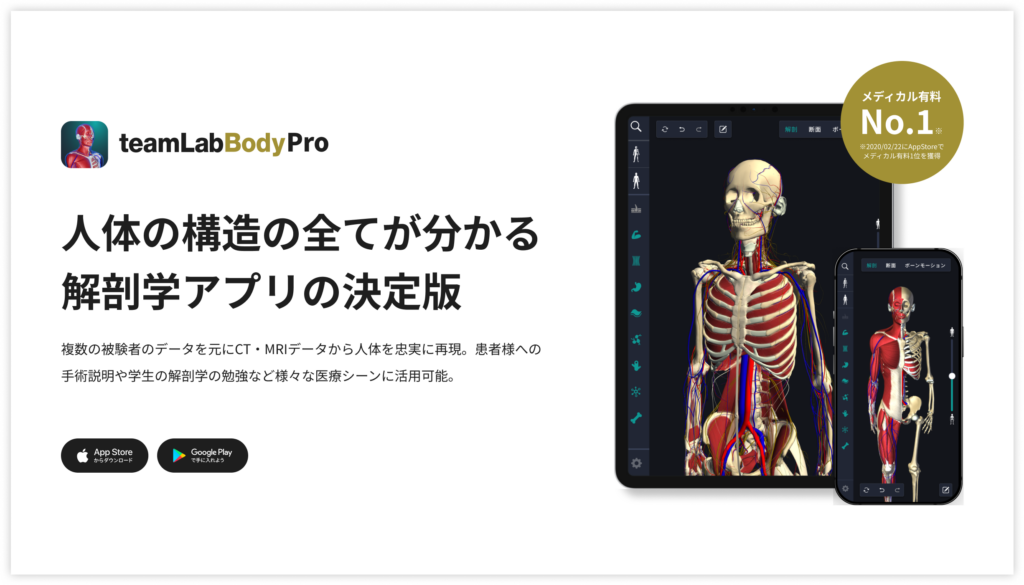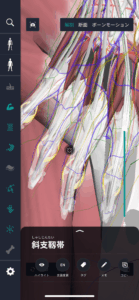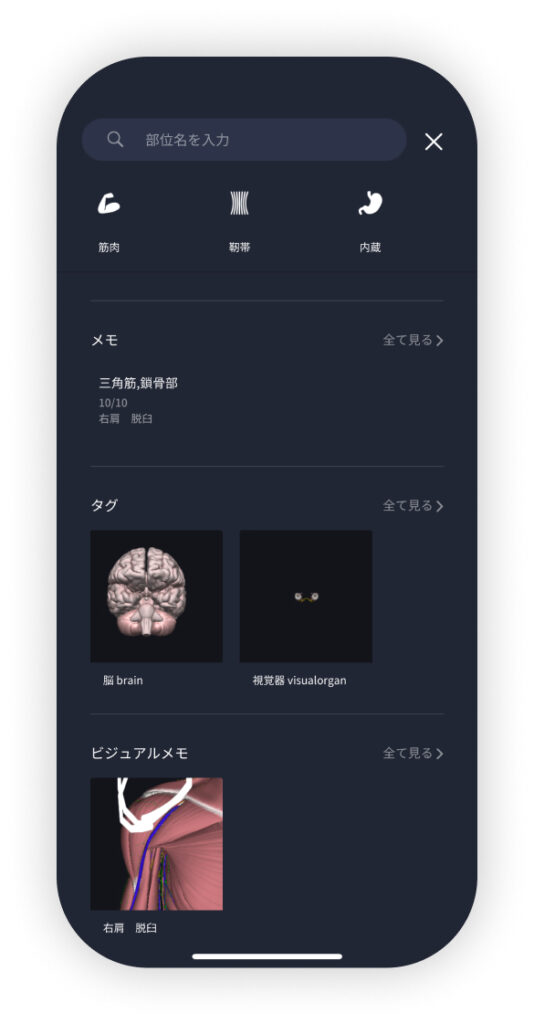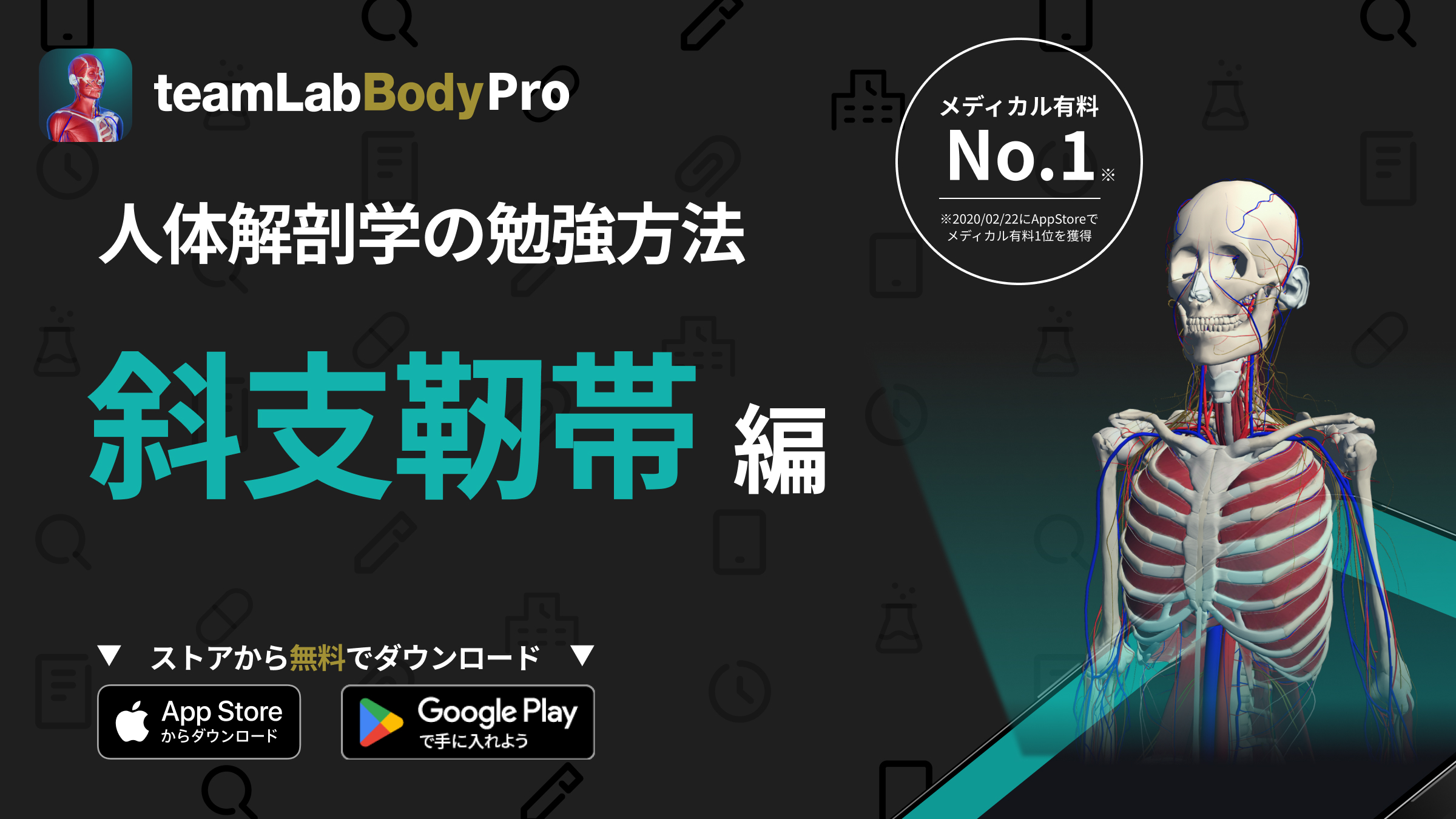beginning
In this article, I will explain effective study methods, starting with knowledge of specialized parts in human anatomy.
In human anatomy, it is necessary not only to memorize the names of various organs, muscles, and bones, but also to remember where they are located in the body. Therefore, it is necessary to learn as efficiently as possible.
I hope you can read this article and use the app to deepen your understanding even a little bit.
Now, I'll explain the details about the “oblique ligament” and how to study human anatomy.
teamLab Body Pro Free Download
A 3D anatomy app that shows all the structures of the human body
Download teamLab Body Pro here!

What is oblique ligament?
In the anatomy application, you can view a selection of anatomy 3D models. In this model, there are various observation methods such as surfaces, cross-sections, and nervous systems. This time, I'll explain using an anatomy application.
About oblique ligament

The oblique ligament is said to be involved in fine adjustment in finger extension movements, and is regarded as important as one of the anatomical structures that enable complex finger movements. It is known that when the function of this ligament is impaired, abnormalities in finger extension patterns occur, and its importance in finger coordination is recognized once again. The oblique ligament is an important component of a complex biomechanical system to support detailed finger movements and tasks involving delicate sensation, and is positioned as an extremely important tissue for understanding finger functional anatomy
Study points
Location and structure of the oblique ligament
The oblique retinacular ligament (oblique retinacular ligament) is a thin fibrous tissue located between the extensor tendon and flexor tendon of the finger, specifically near the distal interphalangeal joint (DIP joint) and the proximal interphalangeal joint (PIP joint) of the finger. This ligament starts from the palm side of the PIP joint, crosses the dorsal side of the finger, and runs characteristic of adhering to the dorsal side of the distal interphalangeal joint. Anatomically, the oblique ligament forms part of the finger's extension mechanism and particularly affects the movement of the distal interphalangeal joint. This ligament works in coordination with the lateral cords of the extensor tendon, and is thought to help with interlocking movements that simultaneously stretch the DIP joint when the PIP joint stretches. However, there are various anatomical views on its exact functional role. The oblique ligament is said to be involved in fine adjustment in finger extension movements, and is regarded as important as one of the anatomical structures that enable complex finger movements. Its presence and running are essential elements in understanding the cooperative movement of each finger joint.
The role and function of the oblique ligament
The oblique ligament is thought to function in cooperation with the lateral cord of the extensor tendon of the finger. Specifically, when the PIP joint is fully extended, it is said that this ligament has the function of promoting extension of the DIP joint via the lateral cord. This makes it possible to smoothly extend the entire finger as a single unit. In other words, the oblique ligament functions as an important component for integrating the movements of each joint and realizing efficient extension movements in a complex mechanism in which multiple finger joints move in conjunction. This function can be said to be a regulator of biomechanical systems, which are essential for performing fine finger movements and delicate tasks.
English notation for oblique ligament
The English notation for oblique ligament is “oblique retinacular ligament.” This name accurately indicates its anatomical features and structure. “oblique (oblique)” is an adjective with the meaning of “oblique” or “inclined,” and it expresses the characteristic that this ligament runs diagonally in the finger. This suggests its unique positional relationship, such as crossing between the extensor tendon and flexor tendon of a finger. “Retinacular (retinacular)” is an adjective with the meaning of “branched” or “reticular,” and is derived from the noun “retinaculum (retinaculum).” Branches refer to fibrous structures that fix tendons in specific locations or control movement. It is suggested that this ligament also plays a role in supporting and coordinating specific tendon movements in the finger extension mechanism. “Ligament (ligament)” is a noun meaning “ligament.” By combining these words, the position, function, and fibrous structure of the “branched ligament that runs diagonally” are accurately expressed. In medical terminology, it is common for each element to be composed of words with specific meanings, and the structure is useful for identifying parts and understanding functions.
How to study human anatomy
I will explain specific study methods using human anatomy applications.
Check your past learning history and practice repeatedly
Here are the steps to check your anatomy learning history and practice iteratively effectively.
1. Check your learning history in the app
Reviewing your learning history with the application is an important step in effectively advancing anatomy learning. First, launch the app and go to the learning history section from the main menu. Many anatomy apps are designed to show your progress in the form of graphs and lists, so you can visually check which parts you've learned about and how much time you've spent.
By using this data, you can understand which areas you have strengths in and where you need to spend more time and effort. We also recommend using a dedicated tag or notebook function to mark areas you are particularly weak at or where you need to relearn. Regularly checking your learning history and looking back on past learning content will lead to efficient review and deepening understanding.
2.Make a plan for iterative learning
Making an efficient repetitive learning plan based on learning history is extremely effective in promoting knowledge retention. First, identify weak points and areas where you need to relearn. Next, arrange these study items into a weekly or monthly calendar and create a specific study schedule. By proceeding in a planned manner, you can learn each part evenly and avoid packing in a large amount of information at once.
Using a task management app or digital calendar to set study reminders is effective. Also, it's important to have the flexibility to regularly review progress and revise plans as needed. By having goals and proceeding with your studies in a planned manner, you can efficiently acquire anatomical knowledge.
3.Use 3D features to learn visually
By utilizing the 3D function, learning anatomy is easier to understand visually. The 3D model shows the structure of the human body three-dimensionally, and each part can be observed in detail. This makes it possible to intuitively grasp positional relationships between deep muscles and organs that are difficult to capture in a planar view. For example, you can learn even the smallest details by rotating specific muscles and bones and zooming in and out.
Also, there are many apps that have the function of displaying cross-sectional views of each part using a 3D model, which is useful for deepening understanding of internal structures. This diversity of visual information helps with memory retention and improves immediate responsiveness in tests and practice situations. By utilizing the 3D function and learning visually, you can learn anatomy knowledge more deeply and efficiently.
Use the memo function concretely

Make notes so you don't forget the things and points you've noticed while studying. The memo function can be used for different purposes, such as inputting text, saving images, and writing memos. Tag your notes to make them easier to review later.
Test your learning regularly in the form of quizzes
Regularly testing what you've learned in a quiz format is a very effective way to anchor your anatomy knowledge. Quiz-style tests help you objectively grasp your level of understanding and areas you lack while repeating knowledge.
For example, by using a learning app to conduct quizzes every specific period, you can reconfirm what you've learned and strengthen your memory. There are a wide range of quiz formats, such as multiple choice questions, fill-in-the-blank questions, and short answer questions, and each helps understanding from a different angle and develops the ability to utilize various types of knowledge.
Get feedback
If possible, get feedback from other learners and experts. It helps you find your own gaps in understanding and areas for improvement. You can also keep yourself motivated to learn by regularly testing yourself. Feeling a sense of accomplishment and progress increases motivation for continuous learning.
summary
This time, I explained how to study about the “oblique ligament” using an application!
Thank you for reading this far.
I would be happy if reading this article helped you learn about anatomy.
Learning is a long, never-ending journey, but I sincerely wish you all the best. Let's continue to study together and work hard for the national exam!
Please look forward to the next blog.




